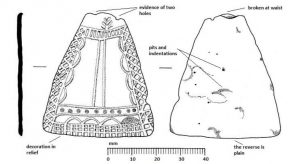June ’19
We’re quite late this month as we started the busy summer module so time has run away with us a bit, but we’re here now with a new object, so better late than never I suppose!
Lead Skirt
This month’s ‘Object of the Month’ is a lead skirt from a female figurine or toy and was uncovered by Gary Bankhead in the River Wear by Elvet Bridge. It is one of the objects that makes up the River Wear Assemblage, which consists of over 12,000 artefacts.

The skirt fragment is most likely from a one-sided flat female figurine dating from the post-medieval period. Although highly stylised, the fragment represents a long skirt which hangs to the ground; it is open in the front showing a petticoat or embroidered underskirt. This style of skirt would have been worn by wealthy women in the 17th century.
The skirt fragment is broken at the waist and would originally have formed part of a full female figure. There is evidence of two holes at the top of the fragment, which is where the arms would have looped away from the body allowing a string or ribbon to be threaded through them enabling the doll to be walked or danced like a puppet.

From the late 16th century onwards, individual standing female figures appear as lead/tin playthings for children. These figures have been categorised into three distinct types:
– Type 1: Seen from the mid to late 16th century, they are usually three dimensional, hollow-cast standing women. None have thus far been recorded outside London.
– Type 2: These are often two-sided flat figures.
– Type 3: These are often one-sided flat figures found in the rural areas of northern England. They are often difficult to date given the crudeness of their manufacture.
The lead skirt fragment in this report can be categorised as Type 3 as it is decorated on one side only and could be characterised as a crudely cast copy of the Type 1 female figure seen below (left). The comparative image below on the right gives an idea of what this object may have looked like originally as the skirt appears almost identical and it’s possible they were made from the same mould.

Historically, children have always contributed to household labour and, either directly or indirectly, to household economies. It is uncertain whether fluctuations in the domestic economy had an adverse effect on the toy market and consumer expenditure on non-essential items. However, toys would only have been produced if parents could afford to purchase them and the growing numbers of recovered toys and fragments suggests that families would occasionally buy them, perhaps as a special indulgence for their children.
Records are insufficient to ascertain how and for who many post-medieval toys were actually used and produced. By considering the manufacture and material of the skirt fragment however, we can attempt to establish its original use as a child’s toy. Items used by children in the context of play are generally highly susceptible to breakage, demonstrate expedient manufacturing techniques, and reflect minimal labour investment. These characteristics are all demonstrated in the object under discussion.
EDXRF analysis of the surface of the skirt fragment revealed that the object is made from lead. There was also the presence of copper, iron and strontium but this is most likely due to deposition onto the surface of the object from the burial environment or from lead ore impurities.

Visual and microscopic examination of the skirt fragment suggests that the object was cast in a one piece, open mould. Lead is an excellent casting metal because its castings are dense and rapidly made and its low melting point allows it to be melted by almost any fuel. These properties allow for a range of decorative mouldings which can be produced quickly and cheaply.
Given the flat and shallow form of the skirt fragment under discussion it would not have required anything more elaborate than a one piece, open mould for its manufacture which would allow for further easily repeated castings to be made.
Additionally, there is no evidence of casting flashes, which are usually seen when metal seeps out between the joins of multiple piece moulds, or file marks where any flashes would have been cleaned up. The reverse has no decoration and is not smooth and has several small pits and indentations which suggest the molten metal was left to cool in the open.
Visit http://www.diveintodurham.uk/home.html to learn more about the Diving into Durham project.
Stay tuned for next month’s object!
